Evidence Critique: Evaluation of Nurse Prescribing in Acute Hospitals
VerifiedAdded on 2020/05/04
|9
|1854
|44
Report
AI Summary
This report presents an evidence critique of a study assessing the adoption of nurse prescribing in an acute hospital setting. The critique examines the context of the nursing prescribing role, its aims, methods, findings, and ethical considerations. The study aimed to explore the role of nurse prescribing, the experiences of nurse prescribers, and the differences between medical and nurse prescribers. The methods included a mixed-methods single-case study, purposive sampling, semi-structured interviews, observations, and questionnaire surveys. The findings revealed benefits such as improved service delivery, positive nurse prescriber attitudes, and no significant differences in prescribing practices compared to doctors, though patient satisfaction varied. The report also suggests areas for further research in the Singaporean context and raises ethical concerns about patient consent. The critique concludes with a discussion of the study's strengths and weaknesses, offering a comprehensive overview of the topic.
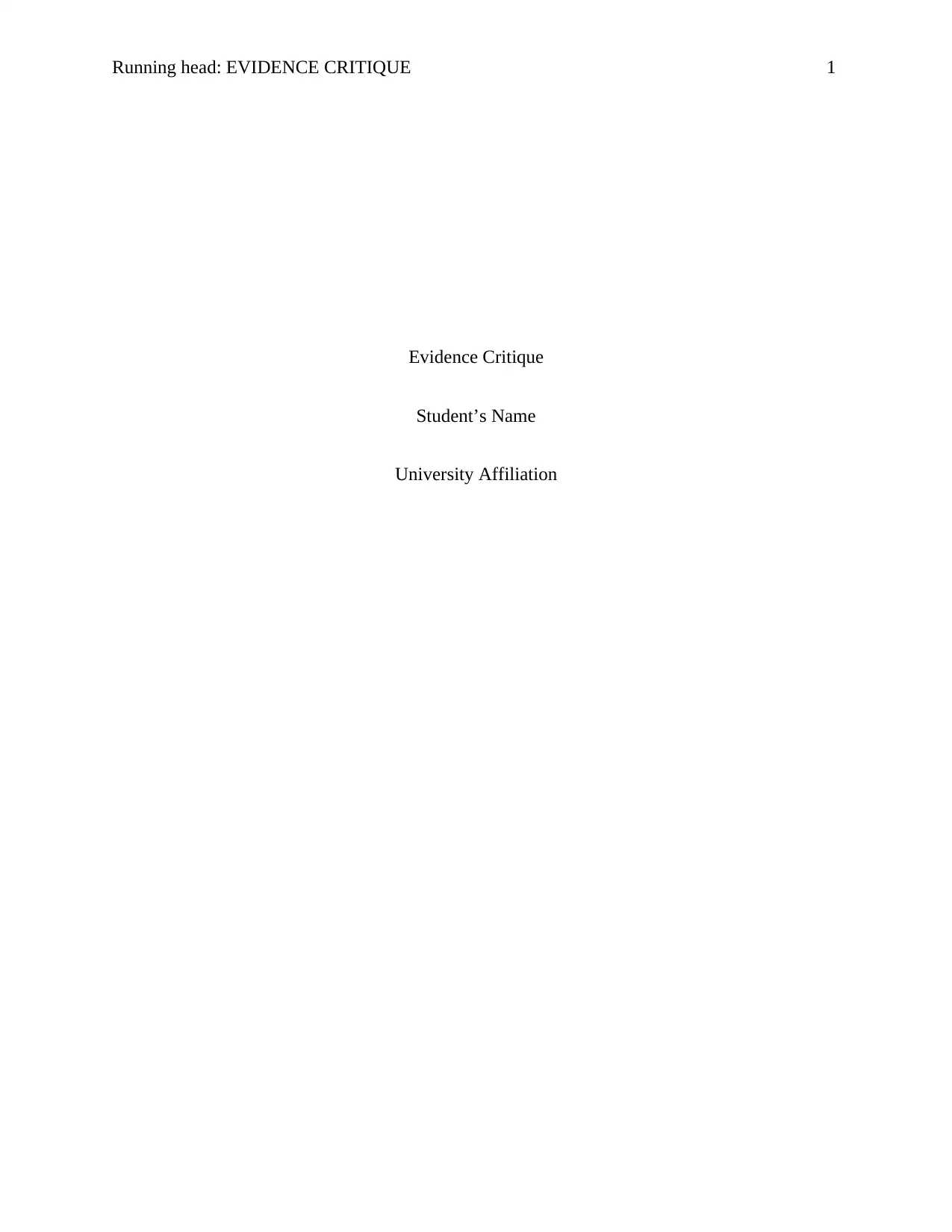
Running head: EVIDENCE CRITIQUE 1
Evidence Critique
Student’s Name
University Affiliation
Evidence Critique
Student’s Name
University Affiliation
Paraphrase This Document
Need a fresh take? Get an instant paraphrase of this document with our AI Paraphraser
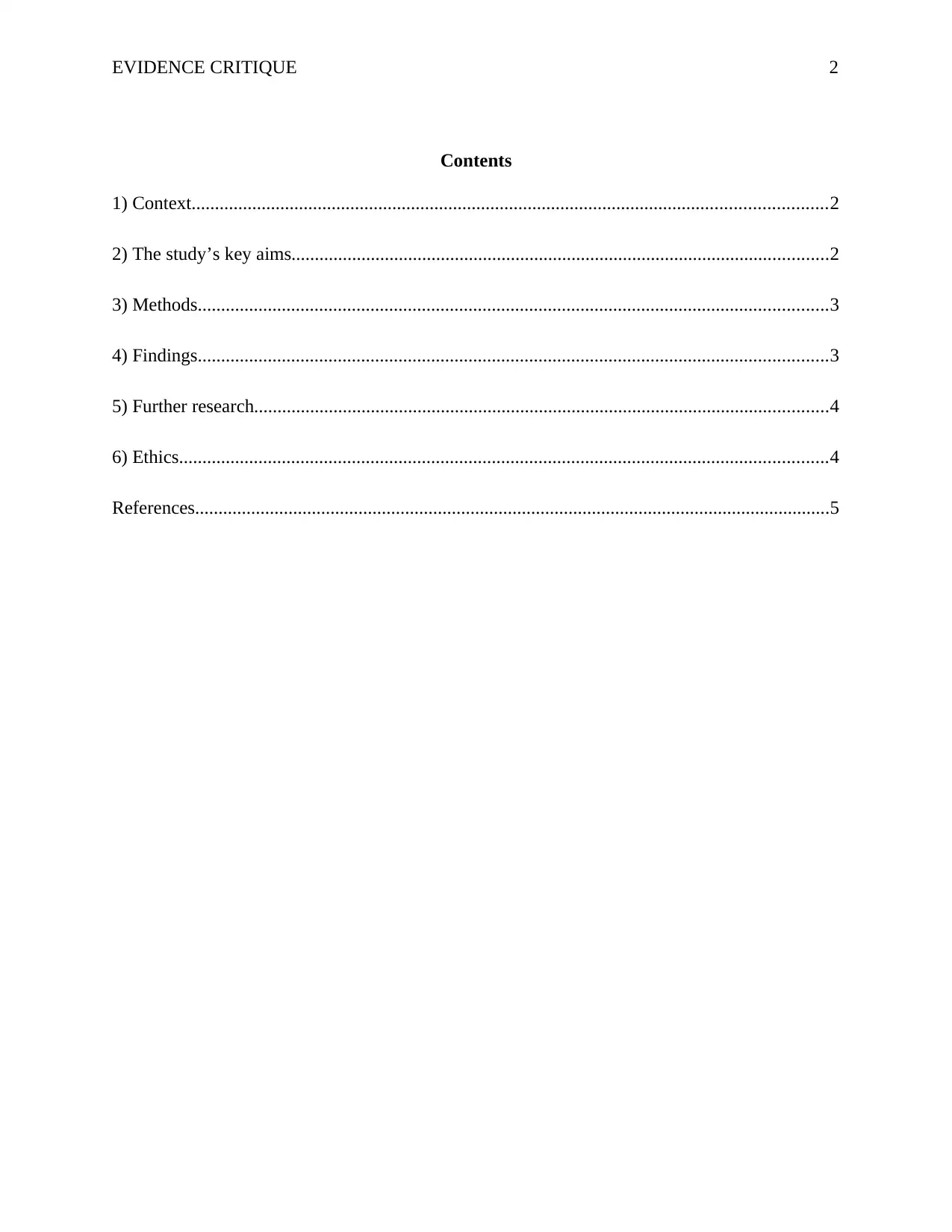
EVIDENCE CRITIQUE 2
Contents
1) Context........................................................................................................................................2
2) The study’s key aims...................................................................................................................2
3) Methods.......................................................................................................................................3
4) Findings.......................................................................................................................................3
5) Further research...........................................................................................................................4
6) Ethics...........................................................................................................................................4
References........................................................................................................................................5
Contents
1) Context........................................................................................................................................2
2) The study’s key aims...................................................................................................................2
3) Methods.......................................................................................................................................3
4) Findings.......................................................................................................................................3
5) Further research...........................................................................................................................4
6) Ethics...........................................................................................................................................4
References........................................................................................................................................5
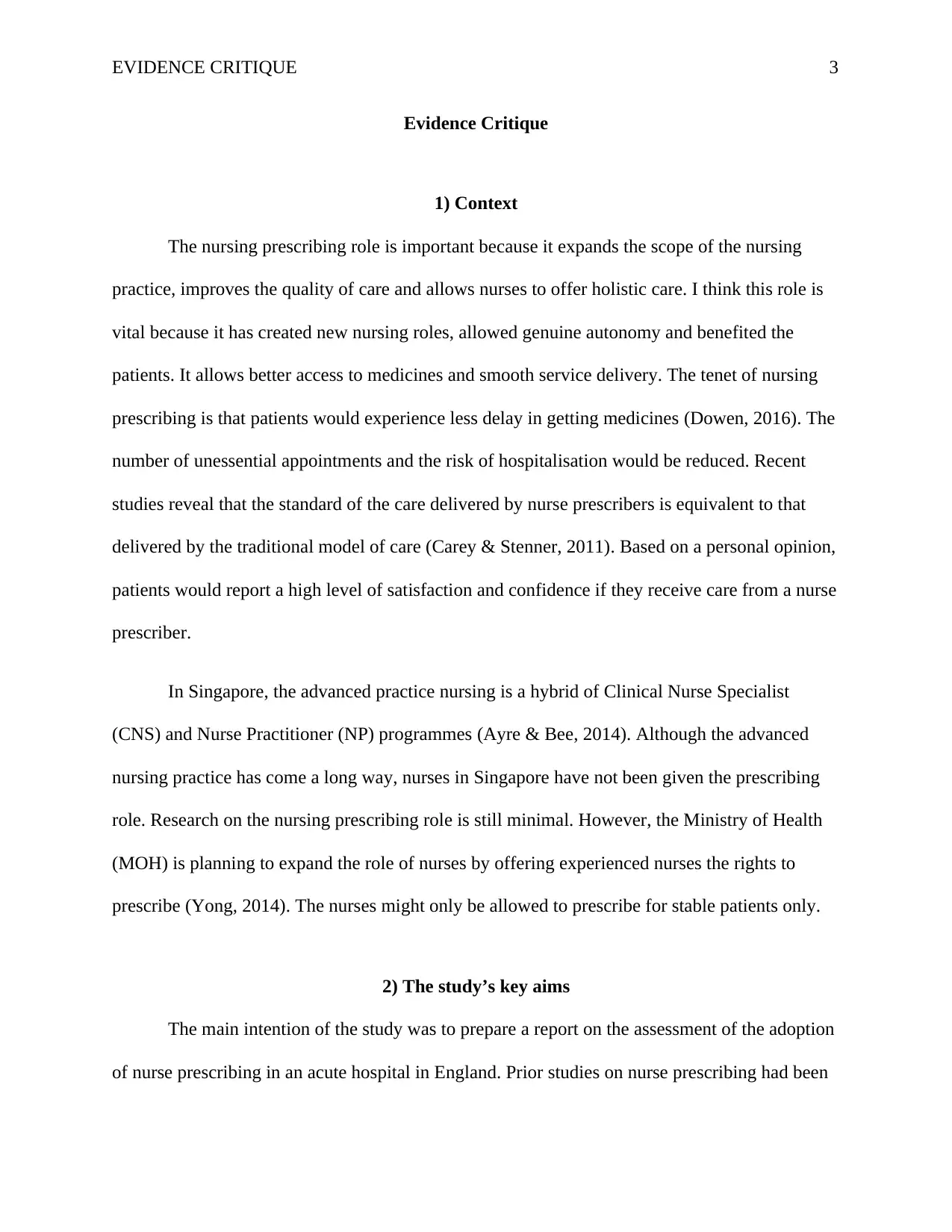
EVIDENCE CRITIQUE 3
Evidence Critique
1) Context
The nursing prescribing role is important because it expands the scope of the nursing
practice, improves the quality of care and allows nurses to offer holistic care. I think this role is
vital because it has created new nursing roles, allowed genuine autonomy and benefited the
patients. It allows better access to medicines and smooth service delivery. The tenet of nursing
prescribing is that patients would experience less delay in getting medicines (Dowen, 2016). The
number of unessential appointments and the risk of hospitalisation would be reduced. Recent
studies reveal that the standard of the care delivered by nurse prescribers is equivalent to that
delivered by the traditional model of care (Carey & Stenner, 2011). Based on a personal opinion,
patients would report a high level of satisfaction and confidence if they receive care from a nurse
prescriber.
In Singapore, the advanced practice nursing is a hybrid of Clinical Nurse Specialist
(CNS) and Nurse Practitioner (NP) programmes (Ayre & Bee, 2014). Although the advanced
nursing practice has come a long way, nurses in Singapore have not been given the prescribing
role. Research on the nursing prescribing role is still minimal. However, the Ministry of Health
(MOH) is planning to expand the role of nurses by offering experienced nurses the rights to
prescribe (Yong, 2014). The nurses might only be allowed to prescribe for stable patients only.
2) The study’s key aims
The main intention of the study was to prepare a report on the assessment of the adoption
of nurse prescribing in an acute hospital in England. Prior studies on nurse prescribing had been
Evidence Critique
1) Context
The nursing prescribing role is important because it expands the scope of the nursing
practice, improves the quality of care and allows nurses to offer holistic care. I think this role is
vital because it has created new nursing roles, allowed genuine autonomy and benefited the
patients. It allows better access to medicines and smooth service delivery. The tenet of nursing
prescribing is that patients would experience less delay in getting medicines (Dowen, 2016). The
number of unessential appointments and the risk of hospitalisation would be reduced. Recent
studies reveal that the standard of the care delivered by nurse prescribers is equivalent to that
delivered by the traditional model of care (Carey & Stenner, 2011). Based on a personal opinion,
patients would report a high level of satisfaction and confidence if they receive care from a nurse
prescriber.
In Singapore, the advanced practice nursing is a hybrid of Clinical Nurse Specialist
(CNS) and Nurse Practitioner (NP) programmes (Ayre & Bee, 2014). Although the advanced
nursing practice has come a long way, nurses in Singapore have not been given the prescribing
role. Research on the nursing prescribing role is still minimal. However, the Ministry of Health
(MOH) is planning to expand the role of nurses by offering experienced nurses the rights to
prescribe (Yong, 2014). The nurses might only be allowed to prescribe for stable patients only.
2) The study’s key aims
The main intention of the study was to prepare a report on the assessment of the adoption
of nurse prescribing in an acute hospital in England. Prior studies on nurse prescribing had been
⊘ This is a preview!⊘
Do you want full access?
Subscribe today to unlock all pages.

Trusted by 1+ million students worldwide
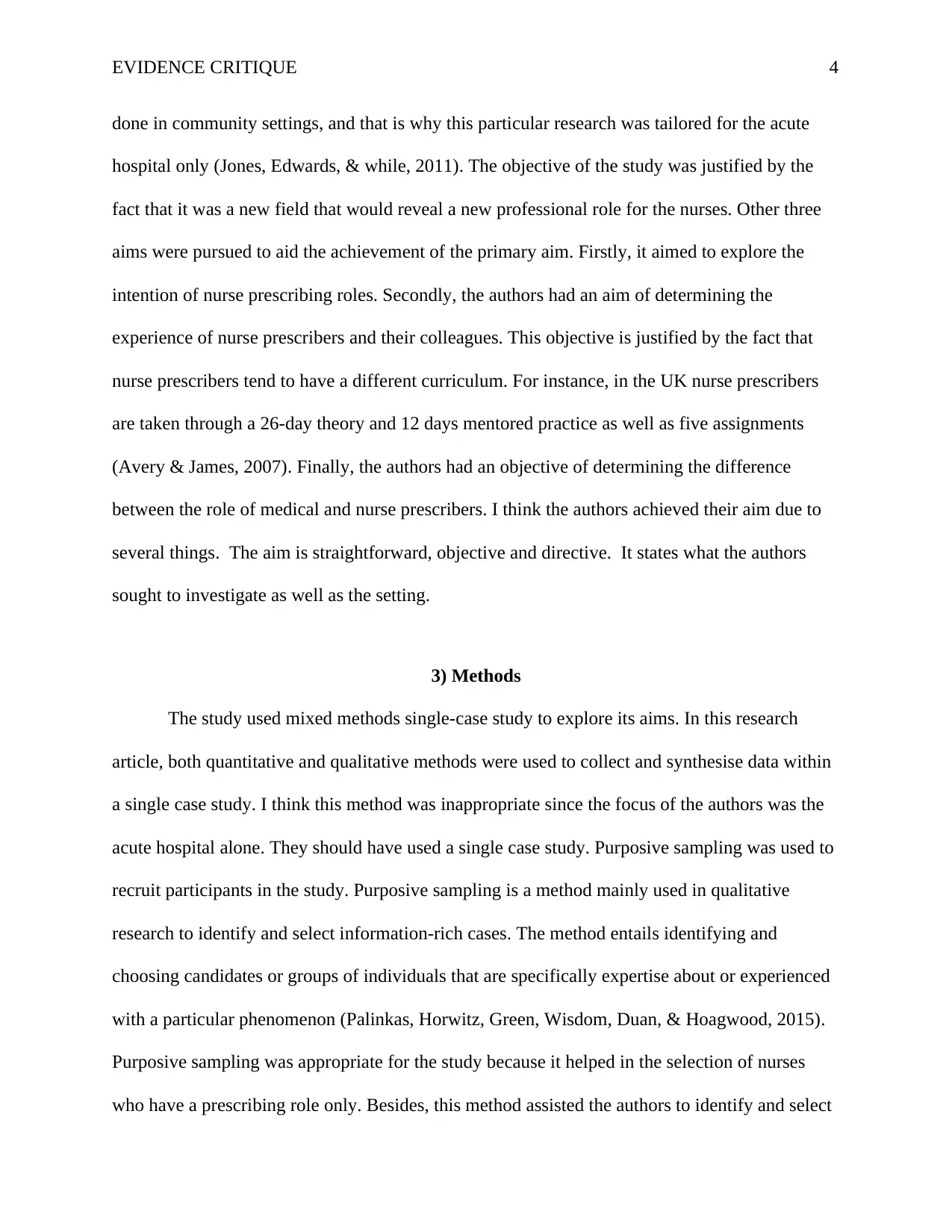
EVIDENCE CRITIQUE 4
done in community settings, and that is why this particular research was tailored for the acute
hospital only (Jones, Edwards, & while, 2011). The objective of the study was justified by the
fact that it was a new field that would reveal a new professional role for the nurses. Other three
aims were pursued to aid the achievement of the primary aim. Firstly, it aimed to explore the
intention of nurse prescribing roles. Secondly, the authors had an aim of determining the
experience of nurse prescribers and their colleagues. This objective is justified by the fact that
nurse prescribers tend to have a different curriculum. For instance, in the UK nurse prescribers
are taken through a 26-day theory and 12 days mentored practice as well as five assignments
(Avery & James, 2007). Finally, the authors had an objective of determining the difference
between the role of medical and nurse prescribers. I think the authors achieved their aim due to
several things. The aim is straightforward, objective and directive. It states what the authors
sought to investigate as well as the setting.
3) Methods
The study used mixed methods single-case study to explore its aims. In this research
article, both quantitative and qualitative methods were used to collect and synthesise data within
a single case study. I think this method was inappropriate since the focus of the authors was the
acute hospital alone. They should have used a single case study. Purposive sampling was used to
recruit participants in the study. Purposive sampling is a method mainly used in qualitative
research to identify and select information-rich cases. The method entails identifying and
choosing candidates or groups of individuals that are specifically expertise about or experienced
with a particular phenomenon (Palinkas, Horwitz, Green, Wisdom, Duan, & Hoagwood, 2015).
Purposive sampling was appropriate for the study because it helped in the selection of nurses
who have a prescribing role only. Besides, this method assisted the authors to identify and select
done in community settings, and that is why this particular research was tailored for the acute
hospital only (Jones, Edwards, & while, 2011). The objective of the study was justified by the
fact that it was a new field that would reveal a new professional role for the nurses. Other three
aims were pursued to aid the achievement of the primary aim. Firstly, it aimed to explore the
intention of nurse prescribing roles. Secondly, the authors had an aim of determining the
experience of nurse prescribers and their colleagues. This objective is justified by the fact that
nurse prescribers tend to have a different curriculum. For instance, in the UK nurse prescribers
are taken through a 26-day theory and 12 days mentored practice as well as five assignments
(Avery & James, 2007). Finally, the authors had an objective of determining the difference
between the role of medical and nurse prescribers. I think the authors achieved their aim due to
several things. The aim is straightforward, objective and directive. It states what the authors
sought to investigate as well as the setting.
3) Methods
The study used mixed methods single-case study to explore its aims. In this research
article, both quantitative and qualitative methods were used to collect and synthesise data within
a single case study. I think this method was inappropriate since the focus of the authors was the
acute hospital alone. They should have used a single case study. Purposive sampling was used to
recruit participants in the study. Purposive sampling is a method mainly used in qualitative
research to identify and select information-rich cases. The method entails identifying and
choosing candidates or groups of individuals that are specifically expertise about or experienced
with a particular phenomenon (Palinkas, Horwitz, Green, Wisdom, Duan, & Hoagwood, 2015).
Purposive sampling was appropriate for the study because it helped in the selection of nurses
who have a prescribing role only. Besides, this method assisted the authors to identify and select
Paraphrase This Document
Need a fresh take? Get an instant paraphrase of this document with our AI Paraphraser
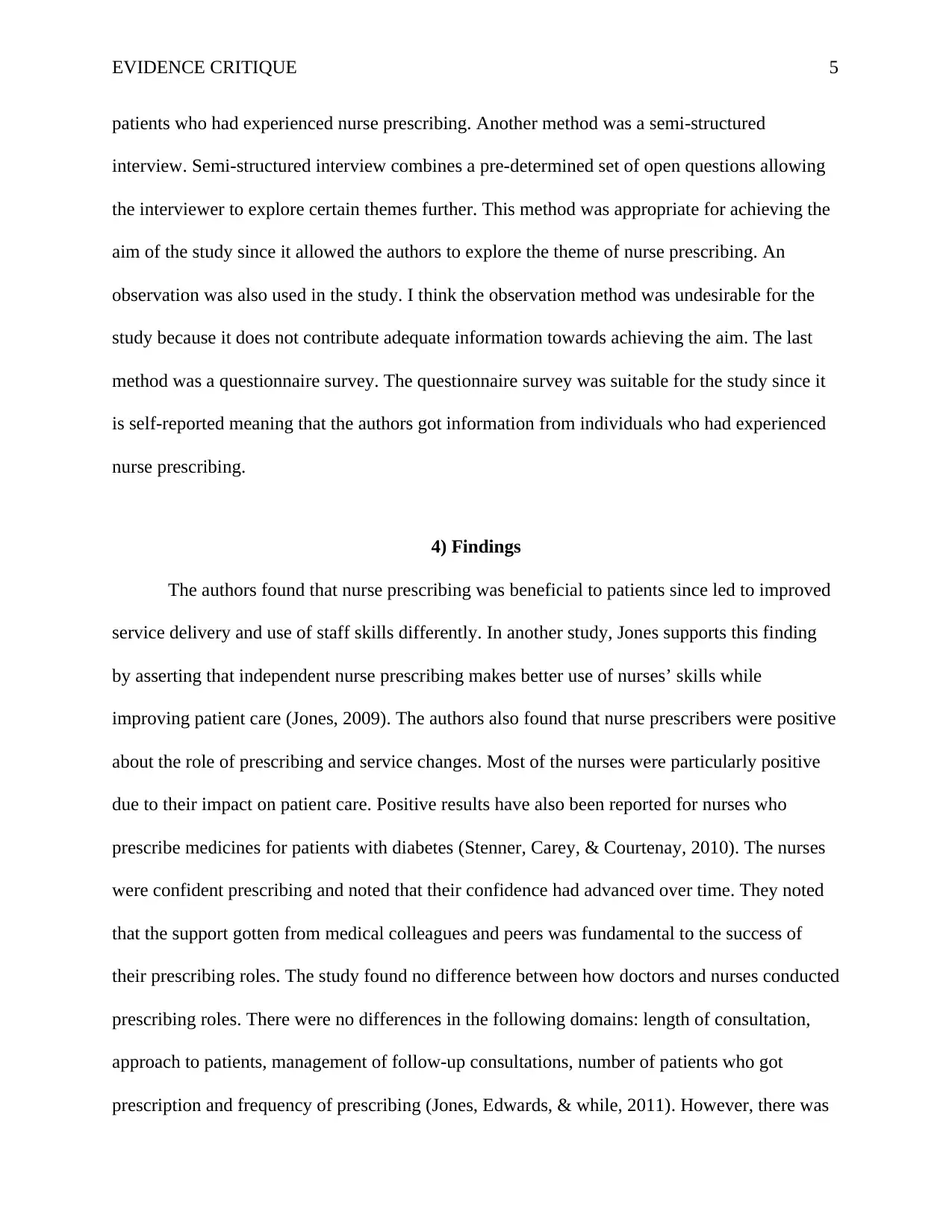
EVIDENCE CRITIQUE 5
patients who had experienced nurse prescribing. Another method was a semi-structured
interview. Semi-structured interview combines a pre-determined set of open questions allowing
the interviewer to explore certain themes further. This method was appropriate for achieving the
aim of the study since it allowed the authors to explore the theme of nurse prescribing. An
observation was also used in the study. I think the observation method was undesirable for the
study because it does not contribute adequate information towards achieving the aim. The last
method was a questionnaire survey. The questionnaire survey was suitable for the study since it
is self-reported meaning that the authors got information from individuals who had experienced
nurse prescribing.
4) Findings
The authors found that nurse prescribing was beneficial to patients since led to improved
service delivery and use of staff skills differently. In another study, Jones supports this finding
by asserting that independent nurse prescribing makes better use of nurses’ skills while
improving patient care (Jones, 2009). The authors also found that nurse prescribers were positive
about the role of prescribing and service changes. Most of the nurses were particularly positive
due to their impact on patient care. Positive results have also been reported for nurses who
prescribe medicines for patients with diabetes (Stenner, Carey, & Courtenay, 2010). The nurses
were confident prescribing and noted that their confidence had advanced over time. They noted
that the support gotten from medical colleagues and peers was fundamental to the success of
their prescribing roles. The study found no difference between how doctors and nurses conducted
prescribing roles. There were no differences in the following domains: length of consultation,
approach to patients, management of follow-up consultations, number of patients who got
prescription and frequency of prescribing (Jones, Edwards, & while, 2011). However, there was
patients who had experienced nurse prescribing. Another method was a semi-structured
interview. Semi-structured interview combines a pre-determined set of open questions allowing
the interviewer to explore certain themes further. This method was appropriate for achieving the
aim of the study since it allowed the authors to explore the theme of nurse prescribing. An
observation was also used in the study. I think the observation method was undesirable for the
study because it does not contribute adequate information towards achieving the aim. The last
method was a questionnaire survey. The questionnaire survey was suitable for the study since it
is self-reported meaning that the authors got information from individuals who had experienced
nurse prescribing.
4) Findings
The authors found that nurse prescribing was beneficial to patients since led to improved
service delivery and use of staff skills differently. In another study, Jones supports this finding
by asserting that independent nurse prescribing makes better use of nurses’ skills while
improving patient care (Jones, 2009). The authors also found that nurse prescribers were positive
about the role of prescribing and service changes. Most of the nurses were particularly positive
due to their impact on patient care. Positive results have also been reported for nurses who
prescribe medicines for patients with diabetes (Stenner, Carey, & Courtenay, 2010). The nurses
were confident prescribing and noted that their confidence had advanced over time. They noted
that the support gotten from medical colleagues and peers was fundamental to the success of
their prescribing roles. The study found no difference between how doctors and nurses conducted
prescribing roles. There were no differences in the following domains: length of consultation,
approach to patients, management of follow-up consultations, number of patients who got
prescription and frequency of prescribing (Jones, Edwards, & while, 2011). However, there was
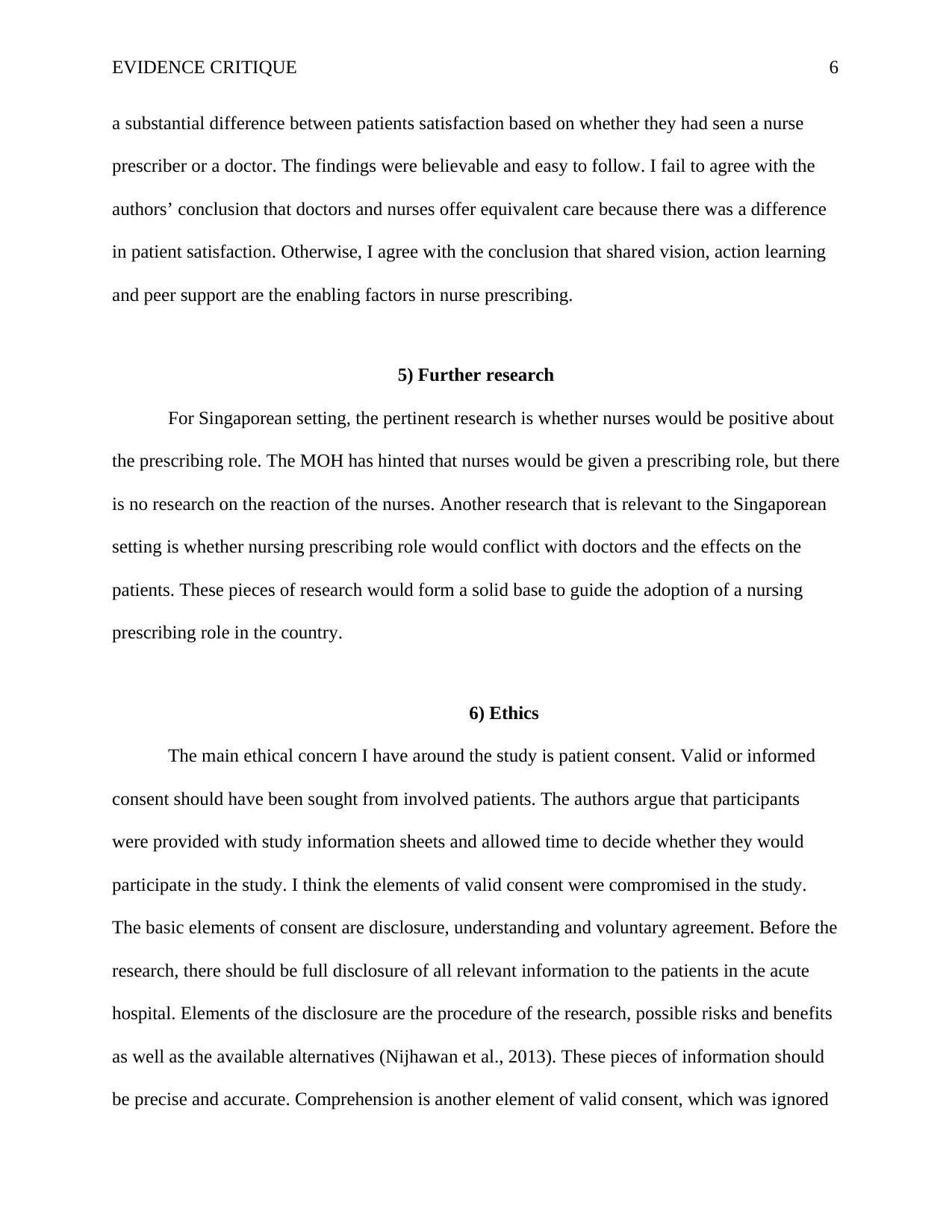
EVIDENCE CRITIQUE 6
a substantial difference between patients satisfaction based on whether they had seen a nurse
prescriber or a doctor. The findings were believable and easy to follow. I fail to agree with the
authors’ conclusion that doctors and nurses offer equivalent care because there was a difference
in patient satisfaction. Otherwise, I agree with the conclusion that shared vision, action learning
and peer support are the enabling factors in nurse prescribing.
5) Further research
For Singaporean setting, the pertinent research is whether nurses would be positive about
the prescribing role. The MOH has hinted that nurses would be given a prescribing role, but there
is no research on the reaction of the nurses. Another research that is relevant to the Singaporean
setting is whether nursing prescribing role would conflict with doctors and the effects on the
patients. These pieces of research would form a solid base to guide the adoption of a nursing
prescribing role in the country.
6) Ethics
The main ethical concern I have around the study is patient consent. Valid or informed
consent should have been sought from involved patients. The authors argue that participants
were provided with study information sheets and allowed time to decide whether they would
participate in the study. I think the elements of valid consent were compromised in the study.
The basic elements of consent are disclosure, understanding and voluntary agreement. Before the
research, there should be full disclosure of all relevant information to the patients in the acute
hospital. Elements of the disclosure are the procedure of the research, possible risks and benefits
as well as the available alternatives (Nijhawan et al., 2013). These pieces of information should
be precise and accurate. Comprehension is another element of valid consent, which was ignored
a substantial difference between patients satisfaction based on whether they had seen a nurse
prescriber or a doctor. The findings were believable and easy to follow. I fail to agree with the
authors’ conclusion that doctors and nurses offer equivalent care because there was a difference
in patient satisfaction. Otherwise, I agree with the conclusion that shared vision, action learning
and peer support are the enabling factors in nurse prescribing.
5) Further research
For Singaporean setting, the pertinent research is whether nurses would be positive about
the prescribing role. The MOH has hinted that nurses would be given a prescribing role, but there
is no research on the reaction of the nurses. Another research that is relevant to the Singaporean
setting is whether nursing prescribing role would conflict with doctors and the effects on the
patients. These pieces of research would form a solid base to guide the adoption of a nursing
prescribing role in the country.
6) Ethics
The main ethical concern I have around the study is patient consent. Valid or informed
consent should have been sought from involved patients. The authors argue that participants
were provided with study information sheets and allowed time to decide whether they would
participate in the study. I think the elements of valid consent were compromised in the study.
The basic elements of consent are disclosure, understanding and voluntary agreement. Before the
research, there should be full disclosure of all relevant information to the patients in the acute
hospital. Elements of the disclosure are the procedure of the research, possible risks and benefits
as well as the available alternatives (Nijhawan et al., 2013). These pieces of information should
be precise and accurate. Comprehension is another element of valid consent, which was ignored
⊘ This is a preview!⊘
Do you want full access?
Subscribe today to unlock all pages.

Trusted by 1+ million students worldwide
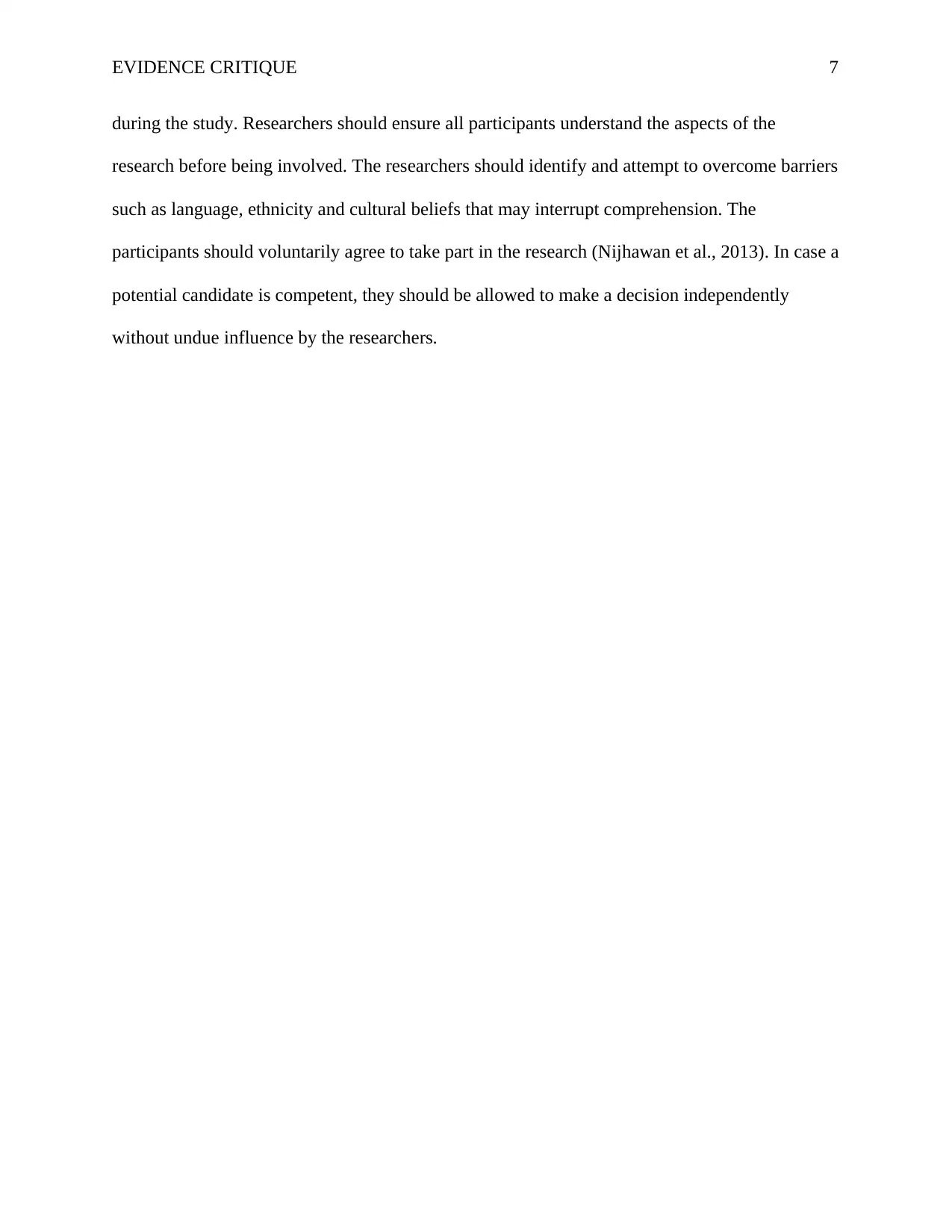
EVIDENCE CRITIQUE 7
during the study. Researchers should ensure all participants understand the aspects of the
research before being involved. The researchers should identify and attempt to overcome barriers
such as language, ethnicity and cultural beliefs that may interrupt comprehension. The
participants should voluntarily agree to take part in the research (Nijhawan et al., 2013). In case a
potential candidate is competent, they should be allowed to make a decision independently
without undue influence by the researchers.
during the study. Researchers should ensure all participants understand the aspects of the
research before being involved. The researchers should identify and attempt to overcome barriers
such as language, ethnicity and cultural beliefs that may interrupt comprehension. The
participants should voluntarily agree to take part in the research (Nijhawan et al., 2013). In case a
potential candidate is competent, they should be allowed to make a decision independently
without undue influence by the researchers.
Paraphrase This Document
Need a fresh take? Get an instant paraphrase of this document with our AI Paraphraser
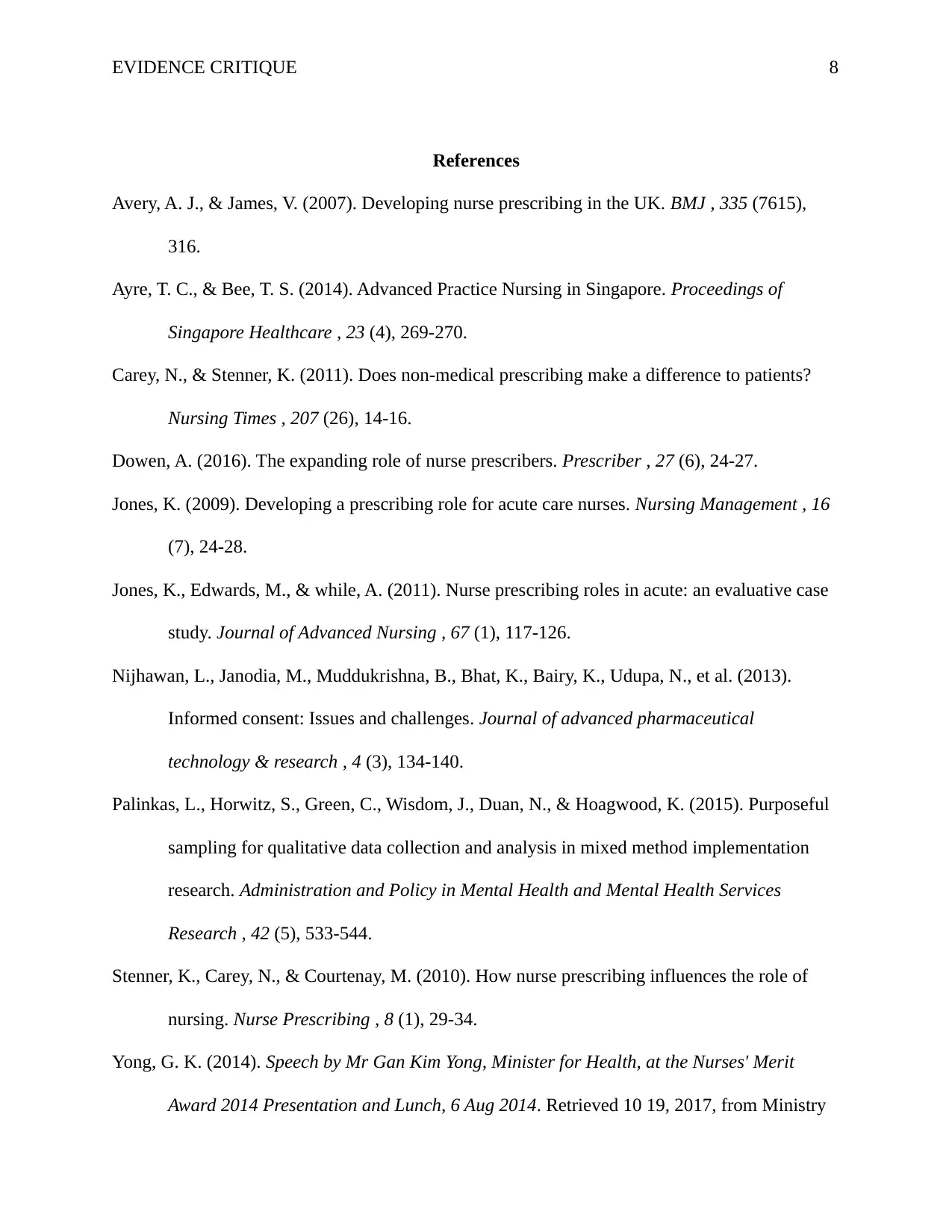
EVIDENCE CRITIQUE 8
References
Avery, A. J., & James, V. (2007). Developing nurse prescribing in the UK. BMJ , 335 (7615),
316.
Ayre, T. C., & Bee, T. S. (2014). Advanced Practice Nursing in Singapore. Proceedings of
Singapore Healthcare , 23 (4), 269-270.
Carey, N., & Stenner, K. (2011). Does non-medical prescribing make a difference to patients?
Nursing Times , 207 (26), 14-16.
Dowen, A. (2016). The expanding role of nurse prescribers. Prescriber , 27 (6), 24-27.
Jones, K. (2009). Developing a prescribing role for acute care nurses. Nursing Management , 16
(7), 24-28.
Jones, K., Edwards, M., & while, A. (2011). Nurse prescribing roles in acute: an evaluative case
study. Journal of Advanced Nursing , 67 (1), 117-126.
Nijhawan, L., Janodia, M., Muddukrishna, B., Bhat, K., Bairy, K., Udupa, N., et al. (2013).
Informed consent: Issues and challenges. Journal of advanced pharmaceutical
technology & research , 4 (3), 134-140.
Palinkas, L., Horwitz, S., Green, C., Wisdom, J., Duan, N., & Hoagwood, K. (2015). Purposeful
sampling for qualitative data collection and analysis in mixed method implementation
research. Administration and Policy in Mental Health and Mental Health Services
Research , 42 (5), 533-544.
Stenner, K., Carey, N., & Courtenay, M. (2010). How nurse prescribing influences the role of
nursing. Nurse Prescribing , 8 (1), 29-34.
Yong, G. K. (2014). Speech by Mr Gan Kim Yong, Minister for Health, at the Nurses' Merit
Award 2014 Presentation and Lunch, 6 Aug 2014. Retrieved 10 19, 2017, from Ministry
References
Avery, A. J., & James, V. (2007). Developing nurse prescribing in the UK. BMJ , 335 (7615),
316.
Ayre, T. C., & Bee, T. S. (2014). Advanced Practice Nursing in Singapore. Proceedings of
Singapore Healthcare , 23 (4), 269-270.
Carey, N., & Stenner, K. (2011). Does non-medical prescribing make a difference to patients?
Nursing Times , 207 (26), 14-16.
Dowen, A. (2016). The expanding role of nurse prescribers. Prescriber , 27 (6), 24-27.
Jones, K. (2009). Developing a prescribing role for acute care nurses. Nursing Management , 16
(7), 24-28.
Jones, K., Edwards, M., & while, A. (2011). Nurse prescribing roles in acute: an evaluative case
study. Journal of Advanced Nursing , 67 (1), 117-126.
Nijhawan, L., Janodia, M., Muddukrishna, B., Bhat, K., Bairy, K., Udupa, N., et al. (2013).
Informed consent: Issues and challenges. Journal of advanced pharmaceutical
technology & research , 4 (3), 134-140.
Palinkas, L., Horwitz, S., Green, C., Wisdom, J., Duan, N., & Hoagwood, K. (2015). Purposeful
sampling for qualitative data collection and analysis in mixed method implementation
research. Administration and Policy in Mental Health and Mental Health Services
Research , 42 (5), 533-544.
Stenner, K., Carey, N., & Courtenay, M. (2010). How nurse prescribing influences the role of
nursing. Nurse Prescribing , 8 (1), 29-34.
Yong, G. K. (2014). Speech by Mr Gan Kim Yong, Minister for Health, at the Nurses' Merit
Award 2014 Presentation and Lunch, 6 Aug 2014. Retrieved 10 19, 2017, from Ministry
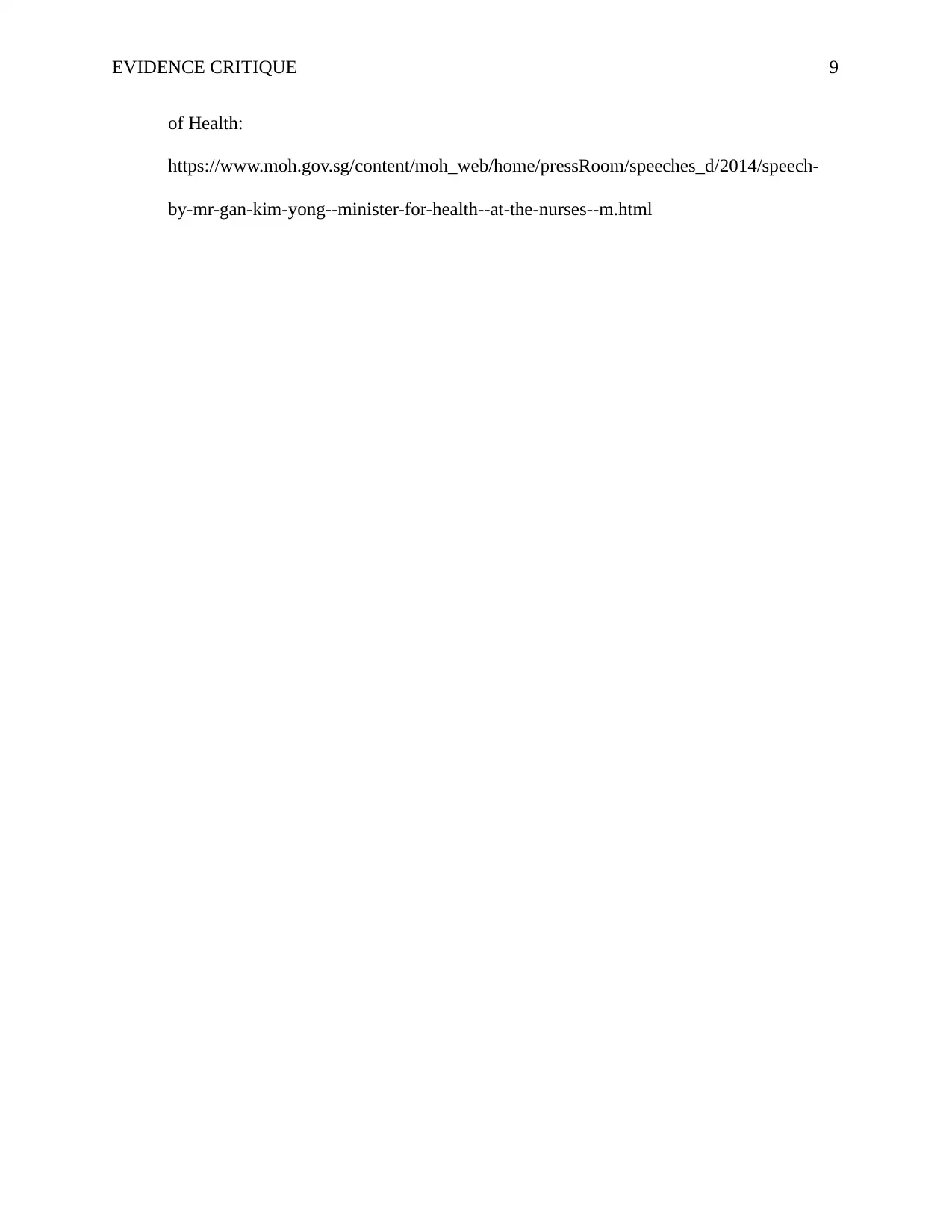
EVIDENCE CRITIQUE 9
of Health:
https://www.moh.gov.sg/content/moh_web/home/pressRoom/speeches_d/2014/speech-
by-mr-gan-kim-yong--minister-for-health--at-the-nurses--m.html
of Health:
https://www.moh.gov.sg/content/moh_web/home/pressRoom/speeches_d/2014/speech-
by-mr-gan-kim-yong--minister-for-health--at-the-nurses--m.html
⊘ This is a preview!⊘
Do you want full access?
Subscribe today to unlock all pages.

Trusted by 1+ million students worldwide
1 out of 9
Related Documents
Your All-in-One AI-Powered Toolkit for Academic Success.
+13062052269
info@desklib.com
Available 24*7 on WhatsApp / Email
![[object Object]](/_next/static/media/star-bottom.7253800d.svg)
Unlock your academic potential
Copyright © 2020–2025 A2Z Services. All Rights Reserved. Developed and managed by ZUCOL.



